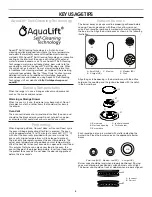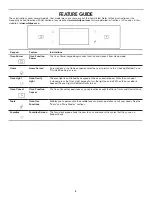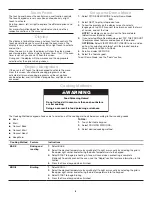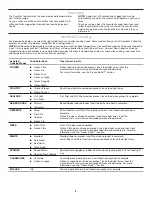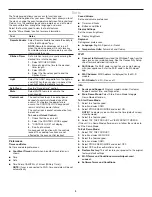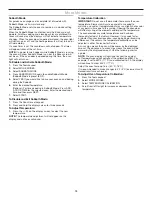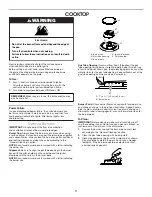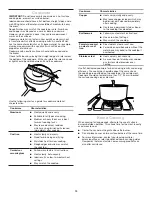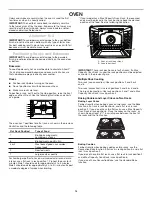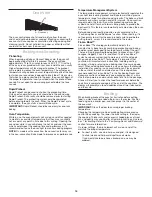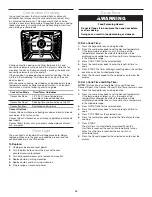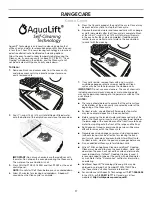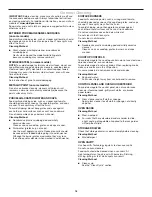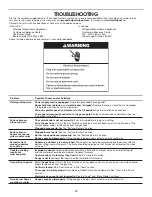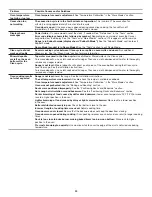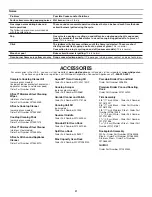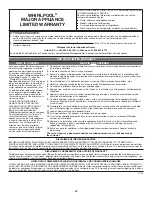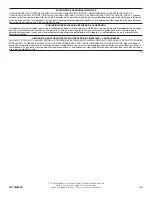
18
General Cleaning
IMPORTANT:
Before cleaning, make sure all controls are off and
the oven and cooktop are cool. Always follow label instructions
on cleaning products. For additional information, you can visit our
website at
www.whirlpool.com
.
Soap, water, and a soft cloth or sponge are suggested first unless
otherwise noted.
EXTERIOR PORCELAIN ENAMEL SURFACES
(on some models)
Food spills containing acids, such as vinegar and tomato, should
be cleaned as soon as the entire range is cool. These spills may
affect the finish.
Cleaning Method:
■
Glass cleaner, mild liquid cleaner or nonabrasive
scrubbing pad:
Gently clean around the model/serial/rating plate
because scrubbing may remove numbers.
STAINLESS STEEL (on some models)
NOTE:
To avoid damage to stainless steel surfaces, do not use
soap-filled scouring pads, abrasive cleaners, cooktop cleaner,
steel-wool pads, gritty washcloths, or abrasive paper towels.
Damage may occur to stainless steel surfaces, even with one-
time or limited use.
Cleaning Method:
Rub in direction of grain to avoid damaging.
METALLIC PAINT (on some models)
Do not use abrasive cleaners, cleaners with bleach, rust
removers, ammonia, or sodium hydroxide (lye) because the
paint surface may stain.
PORCELAIN-COATED GRATES AND CAPS
Food spills containing acids, such as vinegar and tomato,
should be cleaned as soon as the cooktop, grates, and caps
are cool. These spills may affect the finish.
To avoid chipping, do not bang grates and caps against
each other or hard surfaces such as cast iron cookware.
Do not reassemble caps on burners while wet.
Cleaning Method:
■
Nonabrasive plastic scrubbing pad and mildly
abrasive cleanser:
Clean as soon as cooktop, grates, and caps are cool.
■
Dishwasher (grates only, not caps):
Use the most aggressive cycle. Cooked-on soils should
be soaked or scrubbed before going into a dishwasher.
Although the burner grates are durable, they may lose
their shine and/or discolor when washed in a dishwasher.
SURFACE BURNERS
Food spills containing acids, such as vinegar and tomato,
should be cleaned as soon as the cooktop, grates, and caps
are cool. These spills may affect the finish.
To avoid chipping, do not bang grates and caps against
each other or hard surfaces such as cast iron cookware.
Do not reassemble caps on burners while wet.
Do not clean in the Clean cycle.
Do not clean in dishwasher.
Cleaning Method:
■
Nonabrasive plastic scrubbing pad and mildly abrasive
cleanser:
Clean as soon as cooktop, grates, burners, and caps
are cool.
COOKTOP CONTROLS
To avoid damage to the cooktop controls, do not use steel wool,
abrasive cleansers, or oven cleaner.
To avoid damage, do not soak knobs. When replacing knobs,
make sure knobs are in the Off position.
On some models, do not remove seals under knobs.
Cleaning Method:
■
Soap and water:
Pull knobs straight away from control panel to remove.
CONTROL PANEL AND OVEN DOOR EXTERIOR
To avoid damage to the control panel, do not use abrasive
cleaners, steel-wool pads, gritty washcloths, or abrasive
paper towels.
Cleaning Method:
■
Glass cleaner and soft cloth or sponge:
Apply glass cleaner to soft cloth or sponge, not directly
on panel.
OVEN RACKS
Cleaning Method:
■
Steel-wool pad
■
For racks that have discolored and are harder to slide,
a light coating of vegetable oil applied to the rack guides
will help them slide.
STORAGE DRAWER
Check that storage drawer is cool and empty before cleaning.
Cleaning Method:
■
Mild detergent
OVEN CAVITY
Use AquaLift
®
Technology regularly to clean oven spills.
Do not use oven cleaners.
Food spills should be cleaned when oven cools. At
high temperatures, foods react with porcelain. Staining,
etching, pitting, or faint white spots can result.
Cleaning Method:
■
Clean cycle:
See the “Clean Cycle” section.

